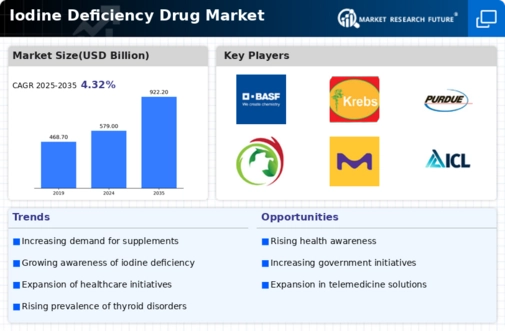Market Trends and Projections
The Global Iodine Deficiency Drug Market Industry is characterized by various trends and projections that indicate its future trajectory. Current estimates suggest a market size of 579.0 USD Billion in 2024, with a potential growth rate of 4.32% CAGR from 2025 to 2035, leading to an anticipated market value of 922.2 USD Billion by 2035. These figures reflect the increasing recognition of iodine's role in health and nutrition, alongside the impact of government policies and consumer awareness. As the market evolves, stakeholders are likely to adapt to these trends, ensuring the availability of effective iodine supplementation options.
Nutritional Supplements Market Growth
The expanding nutritional supplements market is a vital factor influencing the Global Iodine Deficiency Drug Market Industry. As consumers become more health-conscious, there is a notable shift towards dietary supplements that include essential nutrients like iodine. This trend is evident in the rising sales of multivitamins and specific iodine supplements, which cater to diverse consumer needs. The growth of e-commerce platforms further facilitates access to these products, enhancing market penetration. This burgeoning interest in nutritional supplements is expected to contribute significantly to the overall market growth, aligning with the projected market size of 579.0 USD Billion by 2024.
Rising Awareness of Iodine Deficiency
The increasing awareness regarding iodine deficiency and its health implications drives the Global Iodine Deficiency Drug Market Industry. Governments and health organizations are actively promoting education about the importance of iodine in preventing conditions such as goiter and cognitive impairments. For instance, initiatives in various countries aim to fortify salt with iodine, thereby enhancing public health. This heightened awareness is likely to lead to a growing demand for iodine supplementation, contributing to the market's expansion. As a result, the Global Iodine Deficiency Drug Market is projected to reach 579.0 USD Billion by 2024, reflecting the urgency of addressing iodine deficiency.
Government Initiatives and Regulations
Government initiatives play a crucial role in shaping the Global Iodine Deficiency Drug Market Industry. Many countries have implemented mandatory iodization of salt to combat iodine deficiency, which has historically been a public health concern. For example, the World Health Organization recommends universal salt iodization as a key strategy. Such regulations not only promote the consumption of iodine but also stimulate the market for iodine-based supplements and medications. As these initiatives gain traction, the market is expected to experience steady growth, with projections indicating a market size of 922.2 USD Billion by 2035.
Increased Prevalence of Thyroid Disorders
The rising prevalence of thyroid disorders, particularly hypothyroidism, is a significant driver of the Global Iodine Deficiency Drug Market Industry. Thyroid disorders are often linked to inadequate iodine intake, leading to a growing need for iodine supplementation. Reports suggest that thyroid-related conditions affect millions globally, prompting healthcare providers to recommend iodine-rich diets and supplements. This trend is likely to bolster the market, as individuals seek preventive measures against thyroid dysfunction. Consequently, the market is anticipated to grow at a CAGR of 4.32% from 2025 to 2035, reflecting the increasing demand for iodine-related treatments.
Research and Development in Iodine Formulations
Ongoing research and development in iodine formulations are pivotal to the advancement of the Global Iodine Deficiency Drug Market Industry. Pharmaceutical companies are exploring innovative delivery methods and formulations to enhance the bioavailability and efficacy of iodine supplements. This includes the development of new iodine compounds and combination therapies that address specific health concerns. As research progresses, it is anticipated that more effective iodine-based products will enter the market, catering to diverse consumer needs. This innovation is likely to support the market's growth trajectory, with expectations of reaching 922.2 USD Billion by 2035.









